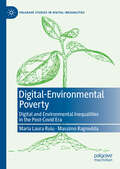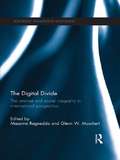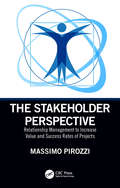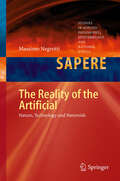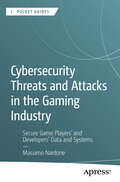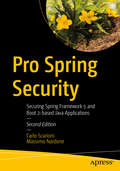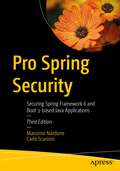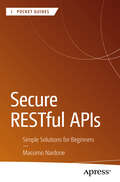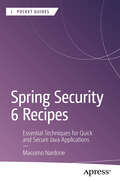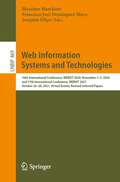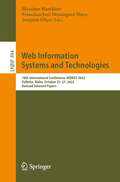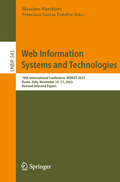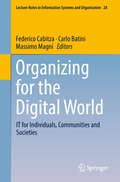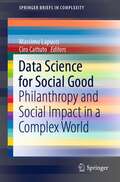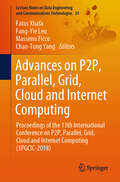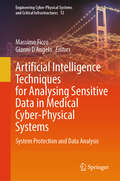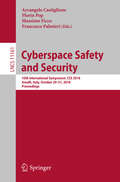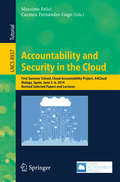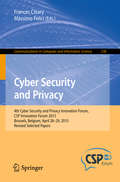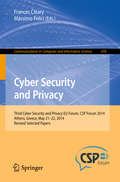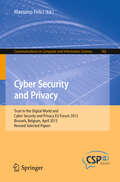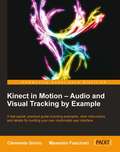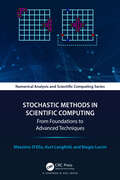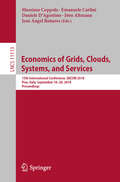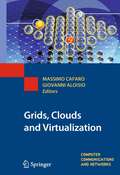- Table View
- List View
Digital-Environmental Poverty: Digital and environmental inequalities in the post-covid era (Palgrave Studies in Digital Inequalities)
by Massimo Ragnedda Maria Laura RuiuThis book analyzes and understands the complexity of digital poverty by considering its intersecting nature with socioeconomic and environmental poverty. The rapid digital acceleration that has characterized contemporary society in recent decades, notably accelerated by the COVID-19 pandemic, has profoundly reshaped societal structures and dynamics. Our direction depends on how we integrate digital technologies into social structures, utilize them for environmental protection, and master their use rather than being passive consumers.Digital Environmental Poverty is split into three sections. Section I explores the multidimensional nature of poverty, emphasizing the necessity to view it beyond economic terms, and placing it within the contemporary digital-environmental evolution. Section II focuses on the environmental dimension of poverty. Section III offers case studies illustrating the interplay between social, digital, and environmental poverty. The conclusion provides recommendations to anticipate and mitigate the risk of digital environmental poverty.
The Digital Divide: The Internet and Social Inequality in International Perspective (Routledge Advances in Sociology)
by Massimo Ragnedda Glenn W. MuschertThis book provides an in-depth comparative analysis of inequality and the stratification of the digital sphere. Grounded in classical sociological theories of inequality, as well as empirical evidence, this book defines ‘the digital divide’ as the unequal access and utility of internet communications technologies and explores how it has the potential to replicate existing social inequalities, as well as create new forms of stratification. The Digital Divide examines how various demographic and socio-economic factors including income, education, age and gender, as well as infrastructure, products and services affect how the internet is used and accessed. Comprised of six parts, the first section examines theories of the digital divide, and then looks in turn at: Highly developed nations and regions (including the USA, the EU and Japan); Emerging large powers (Brazil, China, India, Russia); Eastern European countries (Estonia, Romania, Serbia); Arab and Middle Eastern nations (Egypt, Iran, Israel); Under-studied areas (East and Central Asia, Latin America, and sub-Saharan Africa). Providing an interwoven analysis of the international inequalities in internet usage and access, this important work offers a comprehensive approach to studying the digital divide around the globe. It is an important resource for academic and students in sociology, social policy, communication studies, media studies and all those interested in the questions and issues around social inequality.
The Stakeholder Perspective: Relationship Management to Increase Value and Success Rates of Complex Projects
by Massimo PirozziThe Stakeholder Perspective places people at the center of both projects and project management. It gives to the project management community a helpful, innovative, stakeholder-centered approach to increase projects’ delivered value and success rate. It presents a logical model also called the "Stakeholder Perspective," which acts as the reference point in a structured path to effectiveness. Starting from the analysis of a project’s stakeholders, the model integrates both rational and relational innovative approaches. Its continuous focus on stakeholder requirements and expectations helps to set a proper path, and to maintain it, in order to target success and to achieve goals in a variety of projects with different size and complexity. The book presents a set of innovative and immediately applicable techniques for effective stakeholder identification and classification, as well as analysis of stakeholder requirements and expectations, key stakeholders management, stakeholder network management, and, more generally, stakeholder relationship management. The proposed stakeholder classification model consists of just four communities, each one based on the commonality of main interests and behavior. This model features an accurate and stable identification process to increase effective communication and drastic reduce relationship complexity. A systemic approach is proposed to analyze both stakeholder requirements and expectations. The approach aids in detecting otherwise unclear stakeholder requirements and/or hidden stakeholder expectations. An interactive communication model is presented along with its individual and organizational frames of reference. Also presented are relevant cues to maximize effective and purposeful communication with key stakeholders as well as with the stakeholder network. The importance of satisfying not only the project requirements but also the stakeholder expectations is demonstrated to be the critical success factor in all projects. An innovative approach based on the perceived value and key performance indicators shows how to manage different levels of project complexity. The book also defines a complete structured path to relationship effectiveness called "Relationship Management Project," which can be tailored to enhance stakeholder and communication management processes in each one of the project management process groups (i.e. initiating, planning, executing, monitoring and controlling, and closing). The book concludes with a look ahead at Project Management X.0 and the stakeholder-centered evolution of both project and portfolio management.
The Reality of the Artificial
by Massimo NegrottiThe human ambition to reproduce and improve natural objects and processes has a long history, and ranges from dreams to actual design, from Icarus's wings to modern robotics and bioengineering. This imperative seems to be linked not only to practical utility but also to our deepest psychology. Nevertheless, reproducing something natural is not an easy enterprise, and the actual replication of a natural object or process by means of some technology is impossible. In this book the author uses the term naturoid to designate any real artifact arising from our attempts to reproduce natural instances. He concentrates on activities that involve the reproduction of something existing in nature, and whose reproduction, through construction strategies which differ from natural ones, we consider to be useful, appealing or interesting. The development of naturoids may be viewed as a distinct class of technological activity, and the concept should be useful for methodological research into establishing the common rules, potentialities and constraints that characterize the human effort to reproduce natural objects. The author shows that a naturoid is always the result of a reduction of the complexity of natural objects, due to an unavoidable multiple selection strategy. Nevertheless, the reproduction process implies that naturoids take on their own new complexity, resulting in a transfiguration of the natural exemplars and their performances, and leading to a true innovation explosion. While the core performances of contemporary naturoids improve, paradoxically the more a naturoid develops the further it moves away from its natural counterpart. Therefore, naturoids will more and more affect our relationships with advanced technologies and with nature, but in ways quite beyond our predictive capabilities. The book will be of interest to design scholars and researchers of technology, cultural studies, anthropology and the sociology of science and technology.
Cybersecurity Threats and Attacks in the Gaming Industry: Secure Game Players' and Developers' Data and Systems (Apress Pocket Guides)
by Massimo NardoneLearn about the most common and known threats and attacks in the gaming industry. Cybersecurity is a critical concern in the gaming industry due to the significant financial investments, personal data, and intellectual property at stake. Game developers, publishers, and players all have a vested interest in maintaining a secure gaming environment. This pocketbook is about why cybersecurity in the gaming industry is essential to protect player data, maintain a secure gaming environment, and safeguard intellectual property. Both players and game developers need to remain vigilant, educate themselves about potential threats, and employ best practices to ensure a safe and enjoyable gaming experience. We will describe the most common type of targeted games facing cybersecurity attacks as well as some of the most common types of cyber threats faced by the gaming industry such as malware, distributed denial of service (DDoS) attacks, data breaches, etc. What You Will Learn Describes the importance cybersecurity in the gaming industry Explains key aspects of cybersecurity in the gaming Describes the common types of cyber threats faced by the gaming industry Who Is This Book For The book assumes you have strong gaming development and security knowledge. The book will be written mainly for developers who want to learn how to choose the right tools, what are the best practice, the threats, and vulnerabilities
Pro Spring Security: Securing Spring Framework 5 and Boot 2-based Java Applications
by Massimo Nardone Carlo ScarioniBuild and deploy secure Spring Framework and Spring Boot-based enterprise Java applications with the Spring Security Framework. This book explores a comprehensive set of functionalities to implement industry-standard authentication and authorization mechanisms for Java applications.Pro Spring Security, Second Edition has been updated to incorporate the changes in Spring Framework 5 and Spring Boot 2. It is an advanced tutorial and reference that guides you through the implementation of the security features for a Java web application by presenting consistent examples built from the ground up.This book also provides you with a broader look into Spring security by including up-to-date use cases such as building a security layer for RESTful web services and Grails applications.What You Will LearnExplore the scope of security and how to use the Spring Security FrameworkMaster Spring security architecture and design Secure the web tier in Spring Work with alternative authentication providersTake advantage of business objects and logic securityExtend Spring security with other frameworks and languagesSecure the service layerWho This Book Is ForExperienced Spring and Java developers with prior experience in building Spring Framework or Boot-based applications.
Pro Spring Security: Securing Spring Framework 6 and Boot 3-based Java Applications
by Massimo Nardone Carlo ScarioniBuild and deploy secure Spring Framework and Spring Boot-based enterprise Java applications with the Spring Security Framework. This book explores a comprehensive set of functionalities to implement industry-standard authentication and authorization mechanisms for Java applications.Pro Spring Security, Third Edition has been updated to incorporate the changes in Spring Framework 6 and Spring Boot 3. It is an advanced tutorial and reference that guides you through the implementation of the security features for a Java web application by presenting consistent examples built from the ground up.This book also provides you with a broader look into Spring security by including up-to-date use cases such as building a security layer for RESTful web services and JSON Web Token applications.What You Will LearnExplore the scope of security and how to use the Spring Security FrameworkMaster Spring security architecture and design Secure the web tier in Spring Work with alternative authentication providersTake advantage of business objects and logic securityExtend Spring security with other frameworks and languagesSecure the service layerSecure the application with JSON Web TokenWho This Book Is ForExperienced Spring and Java developers with prior experience in building Spring Framework or Boot-based applications
Secure RESTful APIs: Simple Solutions for Beginners (Apress Pocket Guides)
by Massimo NardoneSecure your RESTful APIs with confidence and efficiency. This straightforward guide outlines the essential strategies and best practices for protecting sensitive data when developing RESTful APIs for your applications. Inside, you’ll explore the fundamental functionalities to implement industry-standard authentication authorization mechanisms for Java applications. With chapters covering key security concerns, data protection, and designing and testing secure APIs, this book provides a hands-on approach to protecting user data, validating inputs, and implementing security mechanisms such as JSON Web Tokens (JWT) and OAuth2 authentication. This book offers a focused introduction without unnecessary complexity. Whether you are a beginner or busy professional, this is the only book designed to help you secure your RESTful APIs in no time. What You Will Learn Understand the fundamentals of RESTful APIs and why it is critical to secure them Identify common security risks concerning RESTful APIs and explore effective protection techniques Know how to design and test RESTful APIs, including with input and response data validation Review examples of how to secure JSON Web Token (JWT) and OAuth3 with RestFUL APIs Who This Book is For Web developer beginners who want to learn how to develop Security RESTful APIs applications
Spring Security 6 Recipes: Essential Techniques for Quick and Secure Java Applications (Apress Pocket Guides)
by Massimo NardoneEnsure robust web security for your Java applications in just a few days. This recipe-driven, practical pocketbook provides a straightforward guide to quickly developing and deploying secure enterprise applications using the Spring 6 Framework, Spring Boot 3, and the H2 database. The book is organized into problems and corresponding recipes, offering solutions for both small and large challenges. First, you will learn how to install all essential development tools, such as IntelliJ IDEA, JDK v17, and Maven. Then you will dive into recipes on using Spring Security 6 with JSP tags and Thymeleaf and integrating security features through Spring Boot 3 Initializr. Finally, you'll be equipped to build your own Spring Boot project using Spring Security, Spring Data JDBC, and the H2 database. This recipes guide is ideal for readers who want to get up and running with only the essential security features in a fraction of time. Its simplified approach offers immediate results for securing Java applications. What You Will Learn Set up and configure Spring Security 6 installation tools Explore the basics of integrating Spring Security 6 with JSP tags, Thymeleaf, and Spring Boot 3 Initializr Build and deploy a secure Spring Boot application using Spring Data JDBC and the H2 database Who This Book Is For Beginners in Spring Security 6, Boot 3 Initializr, and H2 DB, and assumes you have some basic web development and security experience. It is suitable for busy readers who are seeking a simple, focused approach for immediate results. For more comprehensive coverage, detailed explanations, and advanced topics, we recommend Pro Spring Security: Securing Spring Framework 6 and Boot 3-based Java Applications.
Web Information Systems and Technologies: 16th International Conference, WEBIST 2020, November 3–5, 2020, and 17th International Conference, WEBIST 2021, October 26–28, 2021, Virtual Events, Revised Selected Papers (Lecture Notes in Business Information Processing #469)
by Joaquim Filipe Massimo Marchiori Francisco José Domínguez MayoThis book constitutes revised selected papers from the 16th and 17th International Conferences on Web Information Systems and Technologies, WEBIST 2020 and WEBIST 2021, which took place virtually in November 2020 and October 2021, respectively.The 10 full papers from WEBIST 2021 and 1 full paper from WEBIST 2020 presented in this volume were carefully reviewed and selected from originally 48 paper submissions in 2020 and 107 submissions in 2021. The selected papers contribute to the understanding of relevant current research trends in Web information systems and technologies, including deep learning, knowledge representation and reasoning, recommender systems, internet of things, Web intelligence and big data.
Web Information Systems and Technologies: 18th International Conference, WEBIST 2022, Valletta, Malta, October 25–27, 2022, Revised Selected Papers (Lecture Notes in Business Information Processing #494)
by Joaquim Filipe Massimo Marchiori Francisco José Domínguez MayoThis book constitutes revised selected papers from the 18th International Conference on Web Information Systems and Technologies, WEBIST 2022, which took place in Valletta, Malta, in October 2022. The 13 full revised papers presented in this book were carefully reviewed and selected from a total of 62 submissions. The selected papers contribute to the understanding of relevant current research trends in Web information systems and technologies, including deep learning, knowledge representation and reasoning, recommender systems, internet of things, Web intelligence and big data.
Web Information Systems and Technologies: 19th International Conference, WEBIST 2023, Rome, Italy, November 15–17, 2023, Revised Selected Papers (Lecture Notes in Business Information Processing #543)
by Massimo Marchiori Francisco García PeñalvoThis book constitutes the refereed proceedings of the 19th International Conference on Web Information Systems and Technologies, WEBIST 2023, held in Rome, Italy, during November 15–17, 2023. The 5 full papers and 8 short papers included in this book were carefully reviewed and selected from 77 submissions. The selected papers contribute to the understanding of relevant trends of current research on Web Information Systems and Technologies, including: Human Computer Interaction, Application, Research Project and Internet Technology, UX and User-Centric Systems, Web Programming, Web Tools and Languages, Applications, Research Projects and Web Intelligence, Natural Language Processing, Human Factors, Web Information Filtering and Retrieval and Web Interfaces and Applications.
Organizing for the Digital World: It For Individuals, Communities And Societies (Lecture Notes in Information Systems and Organisation #28)
by Massimo Magni Carlo Batini Federico CabitzaThis book argues that “organizing” is a broader term than managing, as it entails understanding how people and machines interact with each other; how resources, data, goods are exchanged in complex and intertwined value chains; and how lines of action and activities can be articulated using flexible protocols and often ad-hoc processes in situated practices of use and production. The book presents a collection of research papers shedding new light on these phenomena and related practices from both academic and professional perspectives. Given the plurality of views that it offers, the book makes a relevant contribution to the understanding and appreciation of the complexity of the digital world at various levels of granularity. It focuses on how individuals, communities and the coopetitive societies of our new, global and hyperconnected world produce value and pursue their objectives and ideals in mutually dependent ways. The content of the book is based on a selection of the best papers - original double-blind peer-reviewed contributions - presented at the annual conference of the Italian chapter of the AIS, which was held in Milan, Italy in October 2017.
Data Science for Social Good: Philanthropy and Social Impact in a Complex World (SpringerBriefs in Complexity)
by Massimo Lapucci Ciro CattutoThis book is a collection of reflections by thought leaders at first-mover organizations in the exploding field of "Data Science for Social Good", meant as the application of knowledge from computer science, complex systems and computational social science to challenges such as humanitarian response, public health, sustainable development. The book provides both an overview of scientific approaches to social impact – identifying a social need, targeting an intervention, measuring impact – and the complementary perspective of funders and philanthropies that are pushing forward this new sector. This book will appeal to students and researchers in the rapidly growing field of data science for social impact, to data scientists at companies whose data could be used to generate more public value, and to decision makers at nonprofits, foundations, and agencies that are designing their own agenda around data.
Advances on P2P, Parallel, Grid, Cloud and Internet Computing: Proceedings of the 13th International Conference on P2P, Parallel, Grid, Cloud and Internet Computing (3PGCIC-2018) (Lecture Notes on Data Engineering and Communications Technologies #24)
by Fatos Xhafa Fang-Yie Leu Massimo Ficco Chao-Tung YangThis book presents the latest research findings, as well as innovative theoretical and practical research results, methods and development techniques related to P2P, grid, cloud and Internet computing. It also reveals the synergies among such large scale computing paradigms. P2P, Grid, Cloud and Internet computing technologies have rapidly become established as breakthrough paradigms for solving complex problems by enabling aggregation and sharing of an increasing variety of distributed computational resources on a large scale. Grid computing originated as a paradigm for high-performance computing, offering an alternative to expensive supercomputers through different forms of large-scale distributed computing. P2P computing emerged as a new paradigm following on from client-server and web-based computing and has proved useful in the development of social networking, B2B (Business to Business), B2C (Business to Consumer), B2G (Business to Government), and B2E (Business to Employee). Cloud computing has been described as a “computing paradigm where the boundaries of computing are determined by economic rationale rather than technical limits”. Cloud computing has fast become the computing paradigm with applicability and adoption in all domains and providing utility computing at large scale. Lastly, Internet computing is the basis of any large-scale distributed computing paradigm; it has very quickly developed into a vast and flourishing field with enormous impact on today’s information societies and serving as a universal platform comprising a large variety of computing forms such as grid, P2P, cloud and mobile computing.
Artificial Intelligence Techniques for Analysing Sensitive Data in Medical Cyber-Physical Systems: System Protection and Data Analysis (Engineering Cyber-Physical Systems and Critical Infrastructures #12)
by Massimo Ficco Gianni D’AngeloThis book presents the major advances in techniques to preserve privacy and security requirements connected with the use of AI and machine learning (ML) to analyse and manage sensitive data in MCPSs. The advances in Internet of things and artificial intelligence (AI) have witnessed great progress on healthcare technologies in several application domains. In particular, the interconnection between the physical spaces, characterized by physical devices able to collect users’ health information, with the cyberspace, also known as the virtual space, has fostered the development of intelligent Medical Cyber-Physical Systems (MCPSs) with the capability to deliver real-time healthcare services. On the other hand, the potential innovation that these technologies bring to improve patient care, by remotely analysing health parameters using medical devices, advanced smart sensors, and AI, is hampered by security and privacy challenges related to the managed sensitive data. Starting from the state of the art on AI and ML for medical applications and digital health, an accurate analysis of privacy and security risks associated with the use of the MCPSs is presented. Then, Digital Twins are introduced as a significant technique to enhance decision-making through learning and reasoning of collected on-field real-time data. Moreover, decentralized healthcare data management approaches based on federated learning, tiny machine learning, and blockchain technologies have been introduced to shift control and responsibility of healthcare data management from individual centralized entities to a more distributed structure, preserving privacy and security. Finally, the application of AI-based security monitoring approaches in healthcare is discussed. In this book, both theoretical and practical approaches are used to allow readers to understand complex topics and concepts easily also through real-life scenarios.
Cyberspace Safety and Security: 10th International Symposium, CSS 2018, Amalfi, Italy, October 29–31, 2018, Proceedings (Lecture Notes in Computer Science #11161)
by Florin Pop Arcangelo Castiglione Francesco Palmieri Massimo FiccoThis book constitutes the proceedings of the 10th International Symposium on Cyberspace Safety and Security, CSS 2018, held in Amalfi, Italy, in October 2018. The 25 full papers presented in this volume were carefully reviewed and selected from 79 submissions.The papers focus on cybersecurity; cryptography, data security, and biometric techniques; and social security, ontologies, and smart applications.
Accountability and Security in the Cloud: First Summer School, Cloud Accountability Project, A4Cloud, Malaga, Spain, June 2-6, 2014, Revised Selected Papers and Lectures (Lecture Notes in Computer Science #8937)
by Massimo Felici Carmen Fernández-GagoThe First A4Cloud Summer School has been one of the first events in the area of accountability and security in the cloud. It was organized by the EU-funded A4Cloud project, in collaboration with the European projects CIRRUS, Coco Cloud, CUMULUS, and SPECS. Cloud computing is a key technology that is being adopted progressively by companies and users across different application domains and industries. Yet, there are emerging issues such as security, privacy, and data protection. The 13 contributions included in this volume cover the state of the art and provide research insights into the following topics: accountability in the cloud; privacy and transparency in the cloud; empirical approaches for the cloud; socio-legal aspects of the cloud; cloud standards; and the accountability glossary of terms and definitions.
Cyber Security and Privacy: 4th Cyber Security and Privacy Innovation Forum, CSP Innovation Forum 2015, Brussels, Belgium April 28-29, 2015, Revised Selected Papers (Communications in Computer and Information Science #530)
by Massimo Felici Frances ClearyThis book constitutes the thoroughly refereed selected papers on the 4th Cyber Security and Privacy Innovation Forum, CSP Forum 2015, held in Brussels, Belgium, in April 2015. The 12 revised full papers presented were carefully reviewed and selected from various submissions. The papers are organized in topical sections such as security and privacy in the cloud; security and privacy technologies; risk and trust; research and innovation in cyber security and privacy.
Cyber Security and Privacy: Third Cyber Security and Privacy EU Forum, CSP Forum 2014, Athens, Greece, May 21-22, 2014, Revised Selected Papers (Communications in Computer and Information Science #470)
by Massimo Felici Frances ClearyThis book constitutes the thoroughly refereed selected papers on the 4th Cyber Security and Privacy Innovation Forum, CSP Forum 2015, held in Brussels, Belgium, in April 2015. The 12 revised full papers presented were carefully reviewed and selected from various submissions. The papers are organized in topical sections such as security and privacy in the cloud; security and privacy technologies; risk and trust; research and innovation in cyber security and privacy.
Cyber Security and Privacy: Trust in the Digital World and Cyber Security and Privacy EU Forum 2013, Brussels, Belgium, April 2013, Revised Selected Papers (Communications in Computer and Information Science #182)
by Massimo FeliciThis book constitutes the thoroughly refereed, selected papers on Cyber Security and Privacy EU Forum 2013, held in Belgium, in April 2013. The 14 revised full papers presented were carefully reviewed and selected from various submissions. The papers are organized in topical sections on cloud computing, security and privacy management, security and privacy technology, security and privacy policy.
Kinect in Motion – Audio and Visual Tracking by Example
by Massimo Fascinari Clemente GiorioThe book includes a series of step-by-step illustrated tutorials supported by detailed explanations for building a multimodal user interface based on Kinect for Windows.Kinect in Motion - Audio and Visual Tracking by Example is great for developers new to the Kinect for Windows SDK, and who are looking to get a good grounding in how to master video and audio tracking. It's assumed that you have some experience in C# and XAML already.
Stochastic Methods in Scientific Computing: From Foundations to Advanced Techniques (Chapman & Hall/CRC Numerical Analysis and Scientific Computing Series)
by Massimo D'Elia Kurt Langfeld Biagio LuciniStochastic Methods in Scientific Computing: From Foundations to Advanced Techniques introduces the reader to advanced concepts in stochastic modelling, rooted in an intuitive yet rigorous presentation of the underlying mathematical concepts. A particular emphasis is placed on illuminating the underpinning Mathematics, and yet have the practical applications in mind. The reader will find valuable insights into topics ranging from Social Sciences and Particle Physics to modern-day Computer Science with Machine Learning and AI in focus. The book also covers recent specialised techniques for notorious issues in the field of stochastic simulations, providing a valuable reference for advanced readers with an active interest in the field.Features Self-contained, starting from the theoretical foundations and advancing to the most recent developments in the field Suitable as a reference for post-graduates and researchers or as supplementary reading for courses in numerical methods, scientific computing, and beyond Interdisciplinary, laying a solid ground for field-specific applications in finance, physics and biosciences on common theoretical foundations Replete with practical examples of applications to classic and current research problems in various fields.
Economics of Grids, Clouds, Systems, and Services: 15th International Conference, GECON 2018, Pisa, Italy, September 18–20, 2018, Proceedings (Lecture Notes in Computer Science #11113)
by Jörn Altmann José Ángel Bañares Massimo Coppola Emanuele Carlini Daniele D’AgostinoThis book constitutes the refereed proceedings of the 15th International Conference on Economics of Grids, Clouds, Systems, and Services, GECON 2018, held in Pisa, Italy, in September 2018. The 21 full papers and 9 short papers presented together with 1 invited talk were carefully reviewed and selected from 40 submissions.This GECON 2018 proceedings was structured in three special sessions on selected topics, namely: IT service ecosystems enabled through emerging digital technologies; machine learning, cognitive systems and data science for system management; and blockchain technologies and economics.
Grids, Clouds and Virtualization
by Giovanni Aloisio Massimo CafaroResearch into grid computing has been driven by the need to solve large-scale, increasingly complex problems for scientific applications. Yet the applications of grid computing for business and casual users did not begin to emerge until the development of the concept of cloud computing, fueled by advances in virtualization techniques, coupled with the increased availability of ever-greater Internet bandwidth. The appeal of this new paradigm is mainly based on its simplicity, and the affordable price for seamless access to both computational and storage resources. This timely text/reference introduces the fundamental principles and techniques underlying grids, clouds and virtualization technologies, as well as reviewing the latest research and expected future developments in the field. Readers are guided through the key topics by internationally recognized experts, enabling them to develop their understanding of an area likely to play an ever more significant role in coming years. Topics and features: presents contributions from an international selection of experts in the field; provides a thorough introduction and overview of existing technologies in grids, clouds and virtualization, including a brief history of the field; examines the basic requirements for performance isolation of virtual machines on multi-core servers, analyzing a selection of system virtualization technologies; examines both business and scientific applications of grids and clouds, including their use in the life sciences and for high-performance computing; explores cloud building technologies, architectures for enhancing grid infrastructures with cloud computing, and cloud performance; discusses energy aware grids and clouds, workflows on grids and clouds, and cloud and grid programming models. This useful text will enable interested readers to familiarize themselves with the key topics of grids, clouds and virtualization, and to contribute to new advances in the field. Researchers, undergraduate and graduate students, system designers and programmers, and IT policy makers will all benefit from the material covered.
